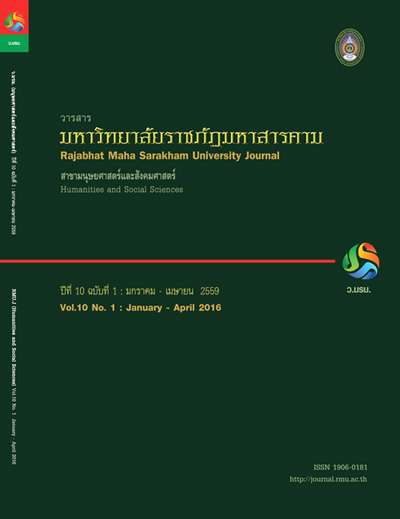การพัฒนาความคิดสร้างสรรค์ของเด็กปฐมวัยด้วยการละเล่นพื้นบ้านไทย; Developing Preschool Children’s Creativity by Using Thai Folk Plays
Main Article Content
บทคัดย่อ
การวิจัยครั้งนี้มีวัตถุประสงค์เพื่อ 1) ศึกษาประสิทธิภาพของแผนการจัดกิจกรรม การละเล่นพื้นบ้านไทย เพื่อการพัฒนาความ
คิดสร้างสรรค์ของเด็กปฐมวัย 2) เปรียบเทียบความคิดสร้างสรรค์ ก่อนเรียนและหลังเรียน ของนักเรียนปฐมวัยที่ผ่านการเรียนรู้ด้วย
แผนการจัดกิจกรรมการละเล่นพื้นบ้านไทย และ 3) ประเมินผลความพึงพอใจของเด็กปฐมวัยที่เรียนด้วยแผนการจัดกิจกรรมการละ
เล่นพื้นบ้านไทย กลุ่มตัวอย่างที่ใช้ในการวิจัยครั้งนี้ ได้แก่ นักเรียนชั้นอนุบาลปีที่ 3 ห้อง 2 จำนวน 27 คน โรงเรียนสาธิตมหาวิทยาลัย
ราชภัฏมหาสารคาม จังหวัดมหาสารคาม ซึ่งได้มาโดยใช้เลือกแบบเจาะจง เครื่องมือที่ใช้ในการวิจัย ได้แก่ แผนการจัดกิจกรรมการละ
เล่นพื้นบ้านไทย แบบทดสอบความคิดสร้างสรรค์ และแบบสอบถามความพึงพอใจ สถิติที่ใช้ในการวิเคราะห์ข้อมูล ได้แก่ ร้อยละ
ค่าเฉลี่ย ส่วนเบี่ยงเบนมาตรฐาน และการทดสอบสมมติฐานใช้ t-test (Dependent Samples) ผลการวิจัยพบว่า
1. ประสิทธิภาพของแผนการจัดกิจกรรมการละเล่นพื้นบ้านไทย เพื่อพัฒนาความคิดสร้างสรรค์ของเด็กปฐมวัย มีประสิทธิภาพ
ตาม 85.09/88.81 ซึ่งสูงกว่าเกณฑ์ที่ตั้งไว้
2. ความคิดสร้างสรรค์ของเด็กปฐมวัยที่ผ่านการเรียนรู้ด้วยแผนการจัดกิจกรรมการละเล่นพื้นบ้านไทย พบว่า คะแนนจาก
การทำแบบทดสอบความคิดสร้างสรรค์ก่อนเรียน มีคะแนนเฉลี่ยโดยรวม เท่ากับ 56.67 คะแนน จากคะแนนเต็ม 100 คะแนน คิดเป็น
ร้อยละ 56.67 คะแนน จากการทำแบบทดสอบความคิดสร้างสรรค์หลังเรียนมีคะแนนเฉลี่ยเท่ากับ 88.81 คะแนนเต็ม 100 คะแนน
คิดเป็นร้อยละ 88.81 อย่างมีนัยสำคัญทางสถิติที่ระดับ .01
3. เด็กปฐมวัยที่เรียนด้วยแผนการจัดกิจกรรมการละเล่นพื้นบ้านไทย มีค่าเฉลี่ยการแสดงความพึงพอใจที่มีต่อแผนการจัด
กิจกรรมการละเล่นพื้นบ้านของไทย ของนักเรียนชั้นอนุบาลปีที่ 3 มีค่าเฉลี่ยระหว่าง 2.59-2.81 แสดงว่าเด็กปฐมวัยมีความพึงพอใจ
ต่อแผนการจัดกิจกรรมการละเล่นพื้นบ้านของไทย ของเด็กชั้นอนุบาลปีที่ 3 อยู่ในระดับพึงพอใจมาก
This research aimed to 1. determine the efficiency of the instructional plans using Thai folk plays to
develop preschool children’s creativity, 2. compare the children’s creativity before and after learning through
use of Thai folk ways, and 3. assess the children’s satisfaction with the learning activities using Thai folk plays.
The sample group for this study consisted of 27 preschool children of kindergarten III, Class II, of Rajabhat
Maha Sarakham University Demonstration School, obtained through purposive sampling. The instruments used
in this study were instructional plans using Thai folk plays to develop preschool children’s creativity, a test for
assessing creativity, and a questionnaire for assessing the children’s satisfaction. The statistics used in analyzing the data were percentage, mean, standard deviation and t-test (Dependent Samples)
Findings of the study are as follows:
1. The efficiency of the instructional plans using Thai folk plays to develop preschool children’s creativity
was 85.09/88.81, which was higher than the required criterion.
2. The preschool children’s mean score of creativity assessed after learning through use of Thai folk
plays was 88.81 %, which was significantly higher than the pretest mean score of 56.67 % at the .01 level of
statistical significance.
3. The satisfaction mean score of the preschool children in Kindergarten III, Class II, who learned through
use of the Thai folk plays, was found within the range of 2.59-2.81, which was determined at the high level of
satisfaction.
Article Details
1. บทความที่ลงตีพิมพ์ทุกเรื่องได้รับการตรวจทางวิชาการโดยผู้ประเมินอิสระ ผู้ทรงคุณวุฒิ (Peer Review) สาขาที่เกี่ยวข้อง อย่างน้อย 3 ท่าน ในรูปแบบ Double blind review
2. ข้อคิดเห็นใด ๆ ของบทความที่ลงตีพิมพ์ในวารสารมหาวิทยาลัยราชภัฏมหาสารคาม นี้เป็นของผู้เขียน คณะผู้จัดทำวารสารไม่จำเป็นต้องเห็นด้วย
3. กองบรรณาธิการวารสารมหาวิทยาลัยราชภัฏมหาสารคาม ไม่สงวนสิทธิ์การคัดลอกแต่ให้อ้างอิงแสดงที่มา


